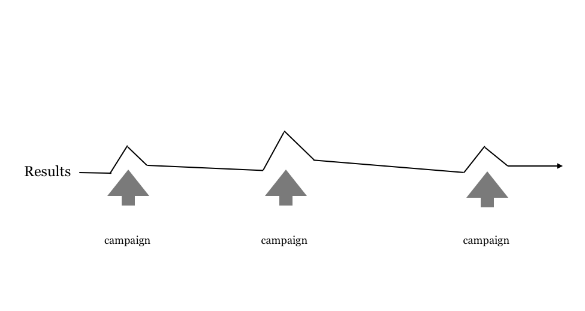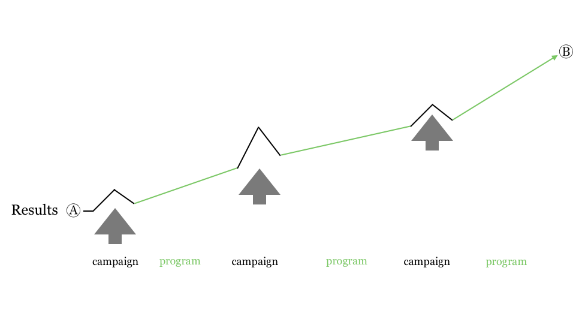As strategic marketing and communication specialists we often claim our role is essential to the long-term strategic viability of our businesses. And I agree.
In fact, thanks to the rise of social, I believe that strategic communications can actually be your company’s competitive advantage. Yet most of what we practice on a daily basis goes directly against this. In particular, I’m referring to our insistent focus on the short-term ‘campaign’.
We should not be blindsided by our complex social media landscape, the shortening attention span of our audiences, or even the sheer speed of communications today, and assume we can solve things by pumping out yet another quick campaign.
That philosophy is actually part of today’s strategic communication problem, not the cure. Instead, we need to rethink the role and purpose of campaigns and build things out from there.
What is a campaign?
You could define a campaign as:
“An operation or series of operations energetically pursued to accomplish a specific purpose at a specific moment in time”
By their very nature, campaigns are temporal. A business, pretty much by definition, is not. Your single most important role as strategic communicator (marketer, PR or other) is to make sure your business is around in the future by building business.
If we and our agencies continually focus on short-term goals (which, by the way, are mostly not met, hence: ‘Quick! Another campaign!’) we’re selling ourselves and our businesses’ bottom line short. We need smarter campaigns.
Our marketing communications equity is the sum of all the communications about a specific business, organisation, product or service that occupies a space within your customer’s or prospect’s mind, over time.
As this 2012 study published in the American Journal of Scientific Research shows, marketing communications strategy is the major thing that contributes to the long-term brand equity that ultimately produces a ‘sale’. By ‘sale’ I mean any business outcome that generates revenue. As Peter Drucker said back in 1974:
“The purpose of marketing is to make selling superfluous.”
Now that’s a worthy goal.
The value of programs
Campaigns come and go. But ‘programs’ deliver ongoing valuable and relevant content that has a long shelf-life and builds – over time – towards a specific business outcome.
Communication programs are the very thing that social media facilitates best. Social channels allow ongoing communication and engagement with your target audience. So you can continually nurture customers and prospects throughout their decision-making process or buying cycle.
To be frank, ‘social’ should be a strategic communicator’s wet dream. Yet, rather ironically, instead of developing content marketing programs that actively shape consumer behaviour over time, we still develop campaign after campaign, holding out for the ‘killer viral’ that will kick us into the big league. Viral is a myth. But that doesn’t mean that campaigns – even tactical ones – are by their nature bad.
The value of tactical campaigns
Messaging obviously needs to change for a given product (or service) over time, for different segments. Campaigns also help address specific issues at any one given moment in time – awareness, perceived quality and so on.
However, when tactical campaigns alone lead our communications efforts, the results look like this:
Notice the little peak, then fairly flat line of results.
Fitting it together: strategy, campaigns and programs
The best and most profitable businesses understand that communications strategy leads; not campaigns. If we’re serious about adding to the long-term strategic viability of our businesses, we need to start allocating commensurate resources to developing the right mix of programs and strategic campaigns. So our results start to look more like this:
That’s better.
Your overall strategy maps out and plans the right combination of campaigns and programs that will get you from ‘A’ (where you are now) to ‘B’ (your annual company business goals) – over time:
1. Marketing communication programs nurture
Programs keep on moving people through their decision or buying cycle about your business. Building sustainable equity. Until you are ready for the next campaign moment.
2. Marketing communication campaigns trigger
Campaigns are specific communications moments that ‘push’ your overall strategy forward. They’re a trigger, a specific call-to-action, that your programs have been nurturing your targets towards. That’s important. A campaign does not work in isolation from programs – or your long-term strategy. It works as part of them.
Start at the top, and work down
When I tell prospects, clients or other agencies that my own consultancy is not really focused on ‘campaigns’, I’m often met with a blank stare. The most common response:
“Oh!? So what do you do?”
I believe that’s symptomatic of today’s dominant marketing and communications philosophy I mentioned earlier. To develop and build long-term marketing communications equity, we start working top-down.
We begin with business goals, and develop strategy built on alignment of our audience needs, our value proposition and positioning.
From there, we design programs that are focused on nurturing our audiences throughout their buying and decision-making cycles.
Once we have programs, we can then create smart, outcome-focused briefs for campaigns that trigger our audiences with a specific call-to-action that leads them towards their next key buying and decision making point. This joins our programs together, and contributes towards our longer-term business goals.
It’s then, and only then, that we get truly strategic campaigns that contribute towards the long-term marketing communications equity of our businesses.

















